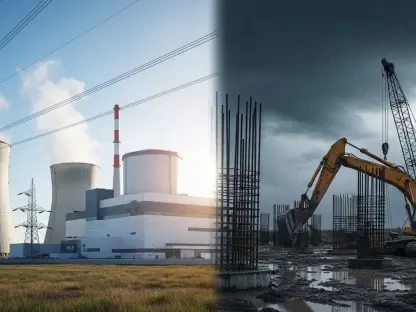The Federal Energy Regulatory Commission’s (FERC) recent meeting spotlighted a range of vital decisions and actions that underscore the complexity and evolving landscape of U.S. energy regulation. The meeting touched on issues ranging from demand response aggregation and the inclusion of tribal communities in energy development to cybersecurity within the energy supply chain. These discussions highlighted the regulatory challenges and new initiatives FERC is tackling to align its policies with contemporary legal, environmental, and societal expectations. Notably, the meeting also featured public protests, highlighting persistent societal tensions concerning energy policy and environmental protection, and marked several critical shifts in FERC’s approach to its regulatory mandate.
Challenging Demand Response Aggregation
One of the pivotal discussions at the FERC meeting revolved around the complaint filed by CPower Energy Management, which contended that PJM Interconnection’s rules created a “Catch-22” scenario, impeding large-scale residential demand response aggregation. CPower argued that the refusal of utilities to supply data from advanced metering infrastructure (AMI) systems hampered their participation in PJM’s markets, potentially increasing energy and capacity prices. Despite CPower’s compelling arguments, FERC found the evidence insufficient to prove the inability to obtain the necessary meter data, asserting that states have jurisdiction over third-party access to certain utility data. Commissioner Judy Chang acknowledged that if conclusive evidence of data access barriers for demand-side resources becomes available, FERC might revisit the issue. This discussion underscores ongoing friction between existing regulatory frameworks and the expanding role of demand response in modern energy markets.
The FERC meeting’s exploration of CPower’s complaint highlights a broader debate about the integration and facilitation of demand response programs within existing energy markets. While advanced metering infrastructure can offer significant opportunities for demand-side energy management, the regulatory environment remains a critical factor. The balance between state and federal jurisdictions over data access and utility regulations continues to be a contentious area. As demand response programs become more integral to energy market efficiency and sustainability, regulators will need to find innovative ways to mediate these disputes. Commissioner Chang’s openness to revisiting the issue if new evidence surfaces is indicative of FERC’s willingness to adapt its regulatory stance in response to evolving market dynamics.
Revising Gas Infrastructure Review Policies
Another crucial theme discussed during the meeting was the prospect of revising FERC’s approach to reviewing gas infrastructure projects. This revision follows several U.S. Court of Appeals decisions that vacated FERC’s approval of specific natural gas pipelines and LNG projects, reflecting the necessity for FERC to update its decades-old policies to meet current legal standards. Chairman Willie Phillips acknowledged that the legal landscape has substantially shifted, necessitating a review of the criteria used for assessing gas infrastructure projects. Despite FERC’s previous attempt in 2022 to adopt new review policies focusing on greenhouse gas emissions and other factors, these were quickly retracted. Instead, Phillips emphasized the need for FERC’s new commissioners to acclimate themselves to ongoing issues. He suggested that future decisions would aim to be more legally sound, balancing environmental impacts while ensuring the affordability and reliability of natural gas services.
Reviewing and updating policies for gas infrastructure projects is essential to ensure they align with both legal standards and modern environmental concerns. The significant court rulings that led to the vacating of certain project approvals indicate a pressing need for more robust and transparent assessment criteria. With greenhouse gas emissions and climate change becoming increasingly pivotal in policy discussions, FERC must integrate these considerations into its review processes. Chairman Phillips’s comments suggest that a balanced approach can be achieved, prioritizing both environmental sustainability and the reliability of natural gas services, particularly crucial as the U.S. approaches the winter season. This balance is fundamental to maintaining public trust and regulatory integrity, ensuring that infrastructure projects meet contemporary standards of legal robustness, environmental responsibility, and energy reliability.
Engaging Tribal Communities in Energy Development
A historic marker of the meeting was FERC’s commitment to engaging tribal communities in electric market issues, reflecting a significant shift towards inclusion and equity. For the first time, FERC will consult with tribes to ease generation interconnection requirements specifically for tribal energy development organizations, following a petition from the Alliance for Tribal Clean Energy. This initiative is poised to make substantial changes, including deferring commercial readiness deposits for generator interconnection requests and exempting tribal organizations from certain interconnection request withdrawal penalties. These changes will enable tribal entities to navigate the complex energy market more effectively, thereby promoting sustainable development within these communities. Such measures are part of FERC’s updated equity action plan, which aims to enhance staff understanding of treaty law and improve engagement with tribal governments. This commitment underscores FERC’s dedication to inclusivity and equitable treatment of diverse stakeholders in the energy sector, marking a progressive step towards integrating tribal interests into national energy policies.
The inclusion of tribal communities in FERC’s policy-making process represents an acknowledgment of their unique position and potential contributions within the energy sector. Historically, tribal communities have faced barriers to participating fully in energy markets due to stringent regulatory requirements and financial constraints. By deferring commercial readiness deposits and exempting tribal organizations from certain penalties, FERC is removing significant obstacles, allowing for greater participation and investment in renewable energy projects on tribal lands. This move aligns with broader governmental efforts to support indigenous communities, recognizing their inherent rights and promoting energy sovereignty. Enhanced engagement and understanding of treaty law among FERC staff further solidify this initiative, ensuring that regulatory practices are sensitive to the historical and legal contexts specific to tribal nations. This progressive approach could serve as a model for increased inclusivity and equity in other regulatory domains, fostering a more just and sustainable energy future.
Strengthening Cybersecurity Measures
Cybersecurity within the energy supply chain was another focal point of the FERC meeting, reflecting growing concerns about the vulnerabilities in an increasingly digitalized grid environment. The commission directed the North American Electric Reliability Corporation (NERC) to identify supply chain risks at regular intervals and extend existing standards to include protected cyber assets. This directive emphasizes the need for continuous vigilance and proactive measures to safeguard critical energy infrastructure. In addition to these directives, FERC approved new standards for internal network security monitoring within an entity’s electronic security perimeter. By enhancing defenses against potential cyber threats, these measures aim to ensure the integrity and security of the nation’s energy infrastructure.
With the rising sophistication of cyber threats, enhancing cybersecurity protocols has become paramount for regulatory bodies like FERC. The integration of digital technologies within the energy grid offers numerous benefits, including improved efficiency and reliability. However, it also introduces new risks that could potentially destabilize the entire energy system. FERC’s directive for NERC to periodically identify supply chain risks and extend standards to protected cyber assets reflects a commitment to addressing these challenges proactively. The newly approved standards for internal network security monitoring signify an additional layer of defense, ensuring that entities can detect and respond to cyber incidents swiftly. This comprehensive approach to cybersecurity underscores the importance of resilience in the face of evolving threats, protecting not only the physical infrastructure but also the data and systems that underpin modern energy markets.
Public Grievances and Environmental Activism
The recent meeting of the Federal Energy Regulatory Commission (FERC) showcased a range of critical decisions and actions, underscoring the complexity and constantly changing nature of U.S. energy regulation. The agenda covered a breadth of topics from demand response aggregation and incorporating tribal communities into energy development to improving cybersecurity within the energy supply chain. These discussions accentuated the regulatory challenges and fresh initiatives FERC is addressing to align its policies with evolving legal, environmental, and societal expectations. Public protests were also a significant feature of the meeting, reflecting ongoing societal tensions surrounding energy policy and environmental safeguards. Importantly, the meeting noted several pivotal shifts in FERC’s regulatory approach, indicating a dynamic evolution in how it fulfills its mandate. By tackling modern issues and engaging with diverse stakeholders, FERC is demonstrating a commitment to adapt and lead in an increasingly complex energy landscape.









